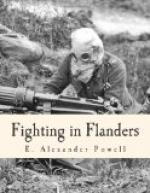At the head of the column rode a squadron of gendarmes—the policemen of the army—gorgeous in uniforms of bottle-green and silver and mounted on sleek and shining horses. After them came the infantry: solid columns of grey-clad figures with the silhouettes of the mounted officers rising at intervals above the forest of spike-crowned helmets. After the infantry came the field artillery, the big guns rattling and rumbling over the cobblestones, the cannoneers sitting with folded arms and heels drawn in, and wooden faces, like servants on the box of a carriage. These were the same guns that had been in almost constant action for the preceding fortnight and that for forty hours had poured death and destruction into the city, yet both men and horses were in the very pink of condition, as keen as razors, and as hard as nails; the blankets, the buckets, the knapsacks, the intrenching tools were all strapped in their appointed places, and the brown leather harness was polished like a lady’s tan shoes. After the field batteries came the horse artillery and after the horse artillery the pom-poms—each drawn by a pair of sturdy draught horses driven with web reins by a soldier sitting on the limber—and after the pom-poms an interminable line of machine-guns, until one wondered where Krupp’s found the time and the steel to make them all. Then, heralded by a blare of trumpets and a crash of kettledrums, came the cavalry; cuirassiers with their steel helmets and breastplates covered with grey linen, hussars in befrogged grey jackets and fur busbies, also linen-covered, and finally the Uhlans, riding amid a forest of lances under a cloud of fluttering pennons. But this was not all, nor nearly all, for after the Uhlans came the sailors of the naval division, brown-faced, bewhiskered fellows with their round, flat caps tilted rakishly and the roll of the sea in their gait; then the Bavarians in dark blue, the Saxons in light blue, and the Austrians—the same who had handled the big guns so effectively—in uniforms of a beautiful silver grey. Accompanying one of the Bavarian regiments was a victoria drawn by a fat white horse, with two soldiers on the box. Horse and carriage were decorated with flowers as though for a floral parade at Nice; even the soldiers had flowers pinned to their caps and nosegays stuck in their tunics. The carriage was evidently a sort of triumphal chariot dedicated to the celebration of the victory, for it was loaded with hampers of champagne and violins!
The army which captured Antwerp was, first, last and all the time, a fighting army. There was not a Landsturm or a Landwehr regiment in it. The men were as pink-cheeked as athletes; they marched with the buoyancy of men in perfect health. And yet the human element was lacking; there was none of the pomp and panoply commonly associated with man; these men in grey were merely wheels and cogs and bolts and screws in a great machine—the word which has been used so often of the German army, yet must be repeated, because there is no other—whose only purpose is death. As that great fighting machine swung past, remorseless as a trip-hammer, efficient as a steam-roller, I could not but marvel how the gallant, chivalrous, and heroic but ill-prepared little army of Belgium had held it back so long.




